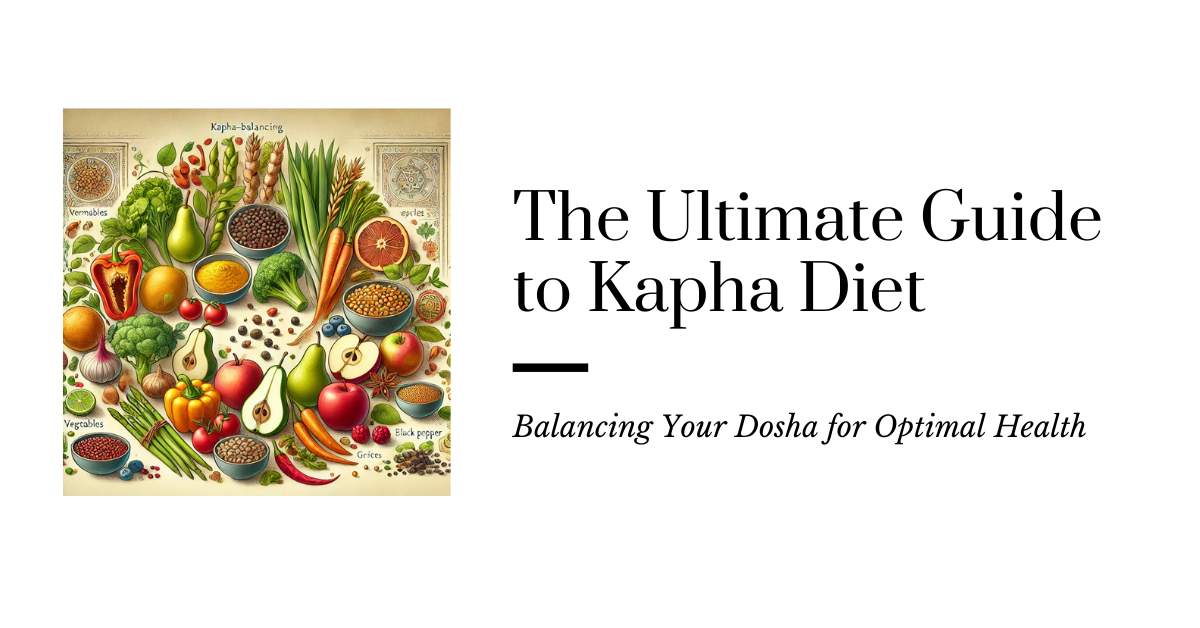In the ancient science of Ayurveda, understanding your dosha is essential for achieving balance and wellness. If you identify with the Kapha dosha, adopting a Kapha diet can help you maintain harmony in your body and mind. This comprehensive guide will explore everything you need to know about the Kapha pacifying diet, including Kapha balancing foods, foods to avoid for Kapha dosha, and practical tips for incorporating these principles into your daily life.
Understanding Kapha Dosha
Kapha is one of the three doshas in Ayurveda, representing earth and water elements. Individuals with a dominant Kapha dosha often exhibit characteristics such as a sturdy build, calm demeanor, and steady energy levels. However, when out of balance, Kapha can lead to issues like weight gain, lethargy, and sluggish digestion.
Read More: Agad Tantra Book: The Ancient Science of Toxicology in Ayurveda
The Importance of a Kapha Diet
A Kapha dosha diet plan focuses on balancing the heavy, cool, and moist qualities of Kapha by incorporating light, warm, and dry foods. By following a Kapha pacifying diet, you can reduce excess Kapha in your system, promoting better digestion, increased energy, and overall well-being.
Kapha Balancing Foods
Best Foods for Kapha Dosha
To balance Kapha, emphasize foods that are:
- Light: Opt for foods that are easy to digest.
- Warm: Choose cooked foods over raw.
- Dry: Incorporate more dry grains and beans.
Fruits
- Apples
- Berries
- Pomegranates
- Cherries
- Peaches
Vegetables
- Leafy greens (kale, spinach)
- Broccoli
- Cauliflower
- Asparagus
- Peppers
Grains
- Barley
- Buckwheat
- Millet
- Rye
- Quinoa
Proteins
- Lentils
- Chickpeas
- Black beans
- Kidney beans
Spices and Herbs
- Ginger
- Turmeric
- Black pepper
- Cinnamon
- Cloves
These Kapha balancing foods stimulate digestion and metabolism, helping to reduce excess Kapha.

Foods to Avoid for Kapha Dosha
Certain foods can aggravate Kapha, leading to imbalance. The following are Kapha increasing foods that should be minimized:
Dairy
- Milk
- Cheese
- Yogurt (especially cold or sweetened)
Sweeteners
- Sugar
- Honey (use sparingly, as it’s heating but heavy)
Oils and Fats
- Excessive oils
- Fried foods
Grains
- Wheat
- Oats
- Rice (especially white)
Fruits
- Bananas
- Avocados
- Coconuts
- Melons
Avoiding these foods to avoid for Kapha dosha helps prevent sluggishness and weight gain.
Kapha Diet Guidelines
Adhering to specific Kapha diet guidelines can enhance the effectiveness of your diet plan:
- Eat at Regular Times: Maintain consistent meal times to support digestion.
- Avoid Overeating: Eat until you’re satisfied, not stuffed.
- Favor Warm Beverages: Drink herbal teas and warm water to stimulate digestion.
- Limit Snacking: Allow time between meals for digestion.
- Use Stimulating Spices: Incorporate spices like ginger and black pepper to enhance metabolism.
Kapha Diet Meal Plan
Creating a Kapha diet meal plan involves selecting appropriate foods for each meal.
Kapha Diet Breakfast
Start your day with a light, warming meal:
- Warm quinoa porridge with cinnamon and apples
- Herbal tea with ginger and lemon
- Toasted rye bread with a thin layer of almond butter
Lunch
Make lunch your largest meal:
- Lentil soup with plenty of vegetables
- Mixed green salad with a light vinaigrette
- Grilled asparagus and bell peppers
Dinner
Keep dinner light and easy to digest:
- Stir-fried vegetables with tofu
- Barley pilaf with herbs
- Steamed broccoli with lemon juice
Kapha Diet Recipes
Incorporate these Kapha diet recipes into your meal plan:
Spicy Lentil Soup
Ingredients:
- Red lentils
- Chopped carrots and celery
- Onions and garlic
- Ginger and turmeric
- Vegetable broth
Instructions:
- Sauté onions, garlic, and spices in a pot.
- Add vegetables and lentils.
- Pour in broth and simmer until lentils are soft.
Quinoa Salad
Ingredients:
- Cooked quinoa
- Chopped cucumbers, tomatoes, and bell peppers
- Fresh parsley and mint
- Lemon juice and olive oil dressing
Instructions:
- Combine quinoa and chopped vegetables in a bowl.
- Toss with herbs and dressing.
- Serve chilled or at room temperature.
Kapha Pacifying Herbs
Certain herbs are particularly beneficial for reducing Kapha:
- Ginger: Stimulates digestion.
- Turmeric: Reduces inflammation.
- Triphala: Aids in detoxification.
- Black Pepper: Enhances metabolism.
Including these Kapha pacifying herbs in your diet can amplify the benefits.
Kapha Weight Loss Diet
For those looking to shed excess weight, a Kapha weight loss diet focuses on reducing heavy and oily foods while increasing metabolic activity.
Tips for Weight Loss
- Increase Physical Activity: Exercise regularly to boost metabolism.
- Eat More Vegetables: Fill half your plate with vegetables.
- Limit Sweets: Reduce sugar and sweet fruits.
- Stay Hydrated: Drink warm water throughout the day.
How to Reduce Kapha Dosha
Balancing Kapha involves lifestyle changes in addition to diet:
- Stay Active: Engage in stimulating activities.
- Wake Up Early: Rise before 6 am to harness energetic hours.
- Avoid Daytime Naps: Stay active during the day.
- Engage in New Experiences: Stimulate the mind with learning and exploration.
These practices, combined with a Kapha pacifying diet, effectively reduce Kapha.
Kapha Diet Shopping List
When grocery shopping, focus on items from your Kapha diet shopping list:
- Fresh fruits (apples, berries)
- Leafy greens and cruciferous vegetables
- Whole grains (quinoa, barley)
- Legumes (lentils, chickpeas)
- Spices (ginger, turmeric)
- Herbal teas (ginger, green tea)
Avoid purchasing Kapha-aggravating foods like dairy, heavy grains, and sweeteners.
Kapha Diet Vegetarian Options
A Kapha diet vegetarian approach is highly effective, emphasizing plant-based foods that are light and nourishing.
Protein Sources
- Legumes (lentils, beans)
- Tofu and tempeh
- Nuts and seeds (in moderation)
Meal Ideas
- Vegetable stir-fries
- Lentil stews
- Quinoa salads with fresh herbs
Read More: Shalakya Tantra Book: The Amazing Ayurvedic Book of ENT and Ophthalmology
Ayurvedic Diet for Kapha
The Ayurvedic diet for Kapha is rooted in traditional practices that aim to balance the dosha through mindful eating and lifestyle habits.
Key Principles
- Eat Mindfully: Focus on your food without distractions.
- Favor Astringent, Bitter, and Pungent Tastes: These tastes reduce Kapha.
- Avoid Cold and Heavy Foods: Opt for warm and light meals.
By following these principles, you align with Ayurvedic wisdom for Kapha balance.
Kapha Detox Diet
Periodically following a Kapha detox diet can help eliminate toxins and reset your system.
Detox Practices
- Consume Warm Liquids: Start the day with warm lemon water.
- Eat Simple Meals: Focus on mono-diet meals like kichari (a blend of rice and mung beans).
- Herbal Support: Use herbs like triphala to aid detoxification.
Consult with an Ayurvedic practitioner before beginning a detox.
Foods That Balance Kapha
Understanding foods that balance Kapha is essential for meal planning.
Emphasize
- Bitter Greens: Arugula, dandelion greens
- Spices: Mustard seeds, cumin, coriander
- Light Proteins: Legumes, white meat (if non-vegetarian)
Limit
- Sweet Fruits: Mangoes, grapes
- Heavy Grains: Wheat, oats
- Oily Foods: Fried items, excessive oils
Incorporating Kapha Diet into Daily Life
Making the Kapha diet a part of your routine involves gradual changes and consistency.
Practical Steps
- Meal Prep: Plan and prepare meals in advance.
- Stay Hydrated: Carry a thermos of herbal tea.
- Spice It Up: Keep a spice kit handy to enhance meals.
- Mindful Eating: Dedicate time to eat without multitasking.
Conclusion
Adopting a Kapha diet tailored to your dosha can profoundly impact your health and well-being. By focusing on Kapha balancing foods, avoiding Kapha increasing foods, and following Kapha diet guidelines, you can achieve balance and vitality. Remember, the journey to wellness is personal, so listen to your body and make adjustments that suit your unique needs.
Whether you’re seeking to reduce excess Kapha, lose weight with a Kapha weight loss diet, or simply embrace the wisdom of Ayurveda through an Ayurvedic diet for Kapha, this guide provides the tools and knowledge to get started.
Embrace the path to harmony and enjoy the benefits of a balanced Kapha dosha.
Read More: Shalya Tantra: The Powerful Ancient Art of Surgery in Ayurveda
